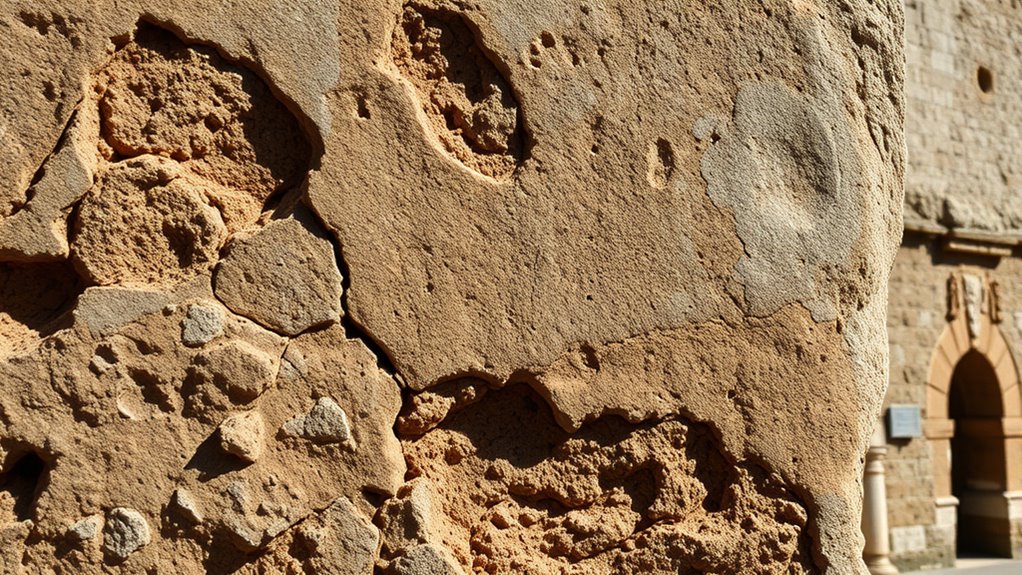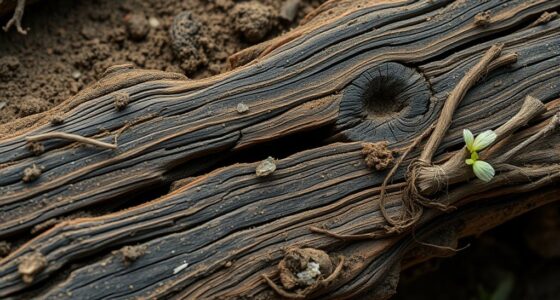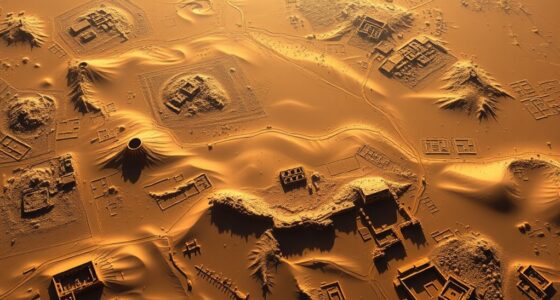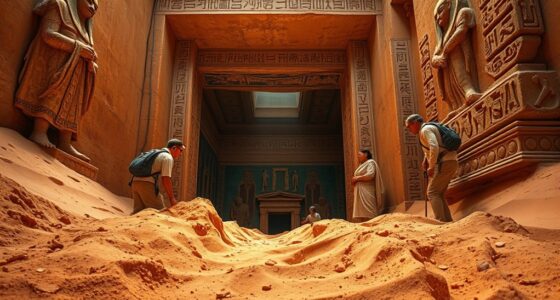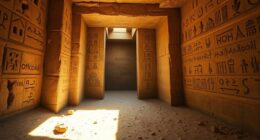Roman concrete still outlasts modern mixtures because it contains volcanic ash, lime, and water that chemically react to create a durable, self-healing material. This composition makes it especially resilient in marine environments, resisting saltwater erosion and cracking for centuries. Unlike modern concrete, Roman versions continue to strengthen over time and withstand ocean conditions. If you’re curious about how ancient engineers achieved such longevity, you’ll discover more about their ingenious use of volcanic materials.
Key Takeaways
- Roman concrete incorporates volcanic ash (pozzolana) that chemically reacts to form a durable, cement-like substance resistant to cracking and erosion.
- Its volcanic ash component provides exceptional resistance to seawater, making it highly durable in marine environments.
- The chemical reactions in Roman concrete enable self-healing, sealing small cracks and maintaining structural integrity over centuries.
- Unlike modern concrete, Roman mixtures lack certain additives, giving Roman concrete superior long-term stability in saltwater and harsh conditions.
- The unique composition and chemical properties of Roman concrete have allowed ancient structures to survive for over two millennia.
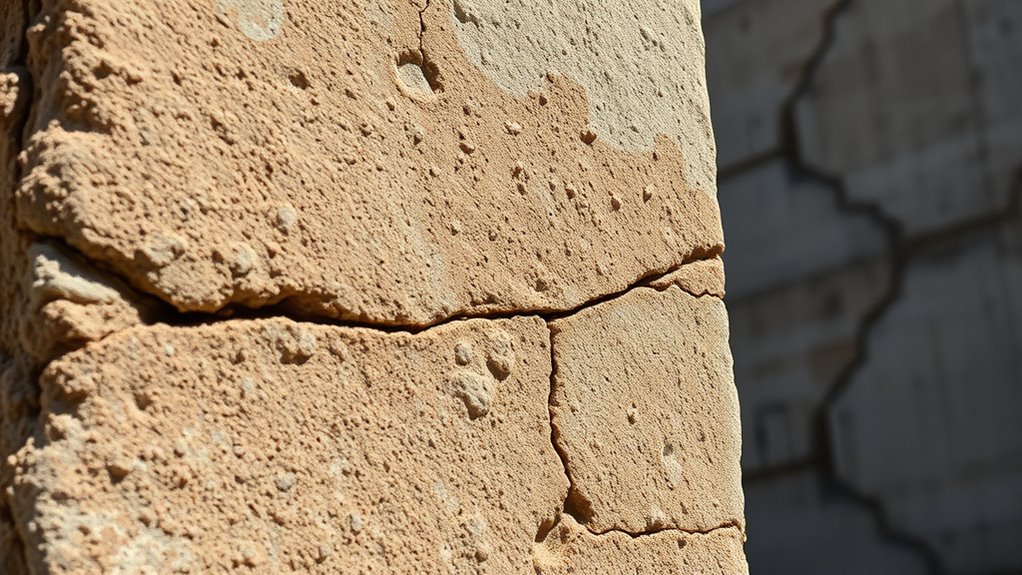
Roman concrete, also known as opus caementicium, is a remarkable building material that allowed the ancient Romans to create durable and impressive structures. Its exceptional longevity, especially in marine environments, continues to astonish engineers and historians alike. The secret to its enduring strength lies partly in its unique composition, particularly its maritime durability, which enabled Roman harbors, piers, and underwater structures to withstand centuries of exposure to saltwater and harsh conditions. Unlike modern concrete, which often deteriorates when exposed to seawater, Roman concrete maintains its integrity, thanks largely to the inclusion of volcanic ash in its mixture.
The volcanic ash used in Roman concrete is no ordinary additive. It’s a type called pozzolana, sourced from volcanic regions around the Bay of Naples. When mixed with lime and water, this ash triggers a chemical reaction that produces a resilient, cement-like substance. This reaction results in a material that is not only strong but also resistant to cracking and erosion. The volcanic ash essentially makes the concrete self-healing over time; small cracks can be sealed as mineral deposits form within them, further enhancing its durability. This process is particularly advantageous in maritime settings, where constant exposure to saltwater would typically weaken modern concrete.
Your understanding of Roman concrete’s maritime durability reveals why so many ancient Roman ports and coastal structures have survived for over two millennia. Modern concrete, which lacks this volcanic ash component, tends to degrade faster when subjected to similar conditions. The Romans’ mastery in incorporating volcanic ash into their concrete mixtures allowed them to build structures that could endure the relentless assault of ocean waves, salt, and moisture. This resilience is evident in iconic sites like the Port of Caesarea and the Roman breakwaters along the Mediterranean, which still stand today, testament to the material’s robustness.
Frequently Asked Questions
Can Roman Concrete Be Environmentally Sustainable?
You’re wondering if Roman concrete can be environmentally sustainable. The good news is, it uses sustainable materials like volcanic ash, which reduces reliance on harmful cement. Plus, its eco-friendly practices, such as lower energy consumption during production, make it a greener choice. By adopting similar techniques and focusing on sustainable materials today, you can create durable, eco-friendly structures that last longer and minimize environmental impact.
How Does Roman Concrete Resist Water Damage?
You might wonder how Roman concrete resists water damage. Its marine durability comes from a special mixture that promotes water resistance, especially against seawater. When exposed to water, Roman concrete reacts with volcanic ash to form a rare mineral called al-tz, which strengthens the material and prevents cracking. This unique chemical reaction grants Roman concrete remarkable water resistance and durability, making it ideal for underwater structures and lasting centuries.
What Modern Innovations Are Inspired by Roman Concrete?
You’re really onto something when you ask about modern innovations inspired by Roman concrete. It’s a case of learning from the past to enhance today’s concrete preservation techniques. Researchers are developing new formulas that mimic ancient durability, like incorporating volcanic ash or alternative binders to improve strength and longevity. These innovations aim to create more sustainable, resilient structures, proving that sometimes, the best way forward is to look back and adapt ancient wisdom.
Is Roman Concrete Suitable for Contemporary Construction?
You might wonder if Roman concrete is suitable for modern construction. Its historical durability proves it can last for centuries, thanks to its unique material composition. Roman concrete’s resilience stems from volcanic ash and lime, which create a chemical reaction that strengthens over time. While traditional concrete is more convenient, incorporating some Roman techniques could improve longevity, especially for structures exposed to harsh environments or needing extended durability.
How Long Does Roman Concrete Typically Last Today?
You’re curious about how long Roman concrete lasts today, right? Its longevity depends on marine durability and other factors like environmental exposure. Roman concrete often endures centuries because its unique composition resists cracking and erosion, especially in marine settings. Modern mixtures struggle with these durability challenges, making Roman concrete’s impressive longevity a result of its specialized materials and construction techniques, which still influence durability studies today.
Conclusion
Roman concrete stands like a timeless masterpiece, weathering centuries like a sturdy old oak against storms. Its secret lies in the ancient recipe, blending volcanic ash and lime into a resilient bond that modern mixtures can only dream of replicating. So next time you marvel at ancient ruins, remember you’re looking at nature’s own blueprint for durability. It’s a reminder that sometimes, the oldest foundations hold the strongest future.
